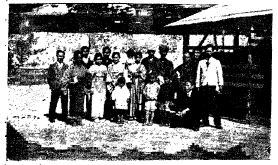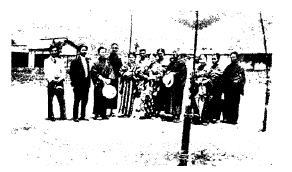|
INLAND SEA
Marlin D. Farnum
It has been thought and sometimes said that, with the sale of the Fukuin Maru a few years ago, the self-sacrificing labors of Captain Bickel and the money invested in the ship were lost to the work of missions. Perhaps many people have forgotten that at the time the decision was made to sell the boat, it was strongly stated that such a move did not mean that the work on the Inland Sea was to be neglected. Without going into the reasons leading up to the sale of the ship, let it be remembered that an agreement was entered into with the groups of believers on the Inland Sea that the proceeds resulting from the sale would be reinvested in church buildings to be erected in the centers of the work: Five locations were chosen, in consultation with the workers, and the money accruing from the sale was allotted for each project, a sum for the purchase of land and another sum for the construction of buildings. In this way the money invested in the Fukuin Maru would not be lost to the work; rather would it continue in service as it provided equipment with which to carry on strong programs of evangelism in centers from which the gospel influence could reach out into the neighboring villages as well as enable the church to secure a firm footing in the central town.
This plan regarding the use of the Fukuin Maru funds was made five years
ago, so that doubtless many are wondering why there has been no report
of the completion of the building program. At the time this agreement was
made, it was thought wise to ask each of the local groups to contribute
one thousand yen towards the projects, In this way the church members were
given a responsibility of their own; whereas in the past everything had
been done for them, now they were to have a definite part in the undertaking
themselves. In seeking to develop the spirit of self-support this was a
wise provision. But it militated against an immediate accomplishment of
the building program, as the Inland Sea groups of Christians are small
numerically and weak financially. The gathering of a thousand yen is not
an easy undertaking, but they have been at work through the years setting
aside a few yen as the individuals were able to contribute. So the main
reason for the delay in the erection of these buildings has been the necessity
of waiting for the contributions of the local groups.
But with the coming of this spring two groups approached the goal so closely
that building plans were drawn up and approval of the Mission Property
Committee was received so that work could commence as soon as their contributions
were completed. And today we are all rejoicing in the fact that work is
actually under way on two of the building projects.
One of these is at Agenosho, on the island of Oshima. About ten years ago a fine piece of land in the center of the town was purchased with money from a specific. After the purchase the town built a new main road directly through a portion of the church land. This gives the church a fine frontage on the main artery of travel through the town and provides an unusual opportunity for evangelistic work.
On the 23rd of May we let the contract for the construction of the Agenosho
church and parsonage and on the same day as many of the members as could
get away from their work gathered on the lot for a short but impressive
service of thanksgiving. Actual construction began the next day, with the
contract calling for the work to be completed by October. The main building
provides a worship room, kindergarten room, kitchenette, and four smaller
rooms which can be used as class rooms for the Church-school and the Peasant
Gospel Schools which we plan to hold from time to time. With this equipment
a strong center of work will be built up in this important town.

Dedication of Site for New Church, Agenosho.
The picture above shows the Agenosho believers at the thanksgiving service.
Pastor Fujiwara is dressed in a dark suit and kneeling in the front row.
His wife is the middle one of the three women dressed in light kimono in
the front row. Mrs. Fujiwara is a graduate of the Juso Bible Training School
and is carrying on the kindergarten at Agenosho in a most effective manner,
though under handicaps due to the present poor quarters. The military officer
is Takasaki Sensei, military instructor attached to the Agenosho Middle
School. It is about a year and a half since he became a Christian; following
deep attachment to the Shin sect of Buddhism, he took up the study of Christianity,
and special meetings conducted by Doctor Axling provided the immediate
stimulus leading to his decision to become a Christian. He is proving to
be one of the strongest workers in the Agenosho church, often speaking
at the services in witness to his experience of faith. Though a military
man, he believes in Peace and sees no way but the Way of Jesus leading
to Peace.
The second place where building operations are beginning is Miyanoura on
the island of Omishima. On the 29th of June the contract for this work
was let and the Christians gathered for a service of thanksgiving. The
contract calls for the building to be completed by October -- so we are
anticipating having the Agenosho dedication and that at Miyanoura at about
the same time. The plans for the building at Miyanoura call for a central
building containing worship room, kindergarten, and a second floor with
four smaller rooms which can be used for Church-school work and Peasant
Gospel Schools or thrown open to provide a gallery over the first floor
when mass meetings are held. As at Agenosho, a suitable parsonage is being
provided.
The picture below shows the Miyanoura group gathered at their

Thanksgiving Service for Land, Miyanoura.
thanksgiving service. On the extreme left in light stands Mr. Hanaoka who came as pastor last April after his graduation from the seminary. The Miyanoura church had been without a pastor for three years until this spring; now that they at last have a leader of Mr. Hanaoka's abilities they are working with added spirit and enthusiasm. Mr. Hanaoka has a passion for rural evangelism and has the ambition of becoming a first class rural worker. These first few months of his pastorate give promise that he will become a real leader. Mr. Watanabe, the postmaster at Miyanoura, stands fifth from the right holding hat and cane. Mr. Watanabe was Captain Bickel's bosom friend, opening up his home for the Captain and his family whenever the ship anchored in the safe harbor at Miyanoura, and standing faithfully by the Captain with valuable advice and the making of contacts which a postmaster in Japan can make. The kindergarten at Miyanoura is conducted by Miss Katayama who stands a little behind and to the right of Mr. Watanabe. The Miyanoura church members contribute for running expenses proportionately more than any of the other Inland Sea groups.
So far actual building is being accomplished only at these two places;
but lately a start was made towards the beginning of the church at Habu,
on the other end of Innoshima, for we have purchased and registered a suitable
piece of land. The Habu members have gathered about two hundred yen towards
their allotment; now with the land purchased they will be spurred on to
making greater efforts. We are hoping that another year will see buildings
erected there, too.
This report will indicate, then, that as fast as the Christians of the
Inland Sea succeed in making their contributions toward the building projects
and as soon as satisfactory land is found, the carrying out of the plan
for the use of the Fukuin Maru funds proceeds.
|